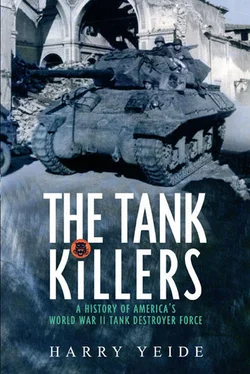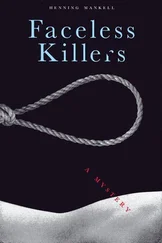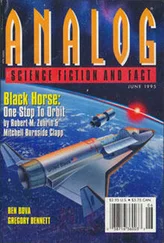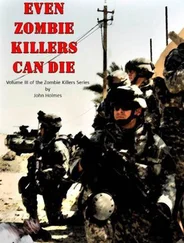Harry Yeide
THE TANK KILLERS
A History of America’s World War II Tank Destroyer Force

An M3 on maneuvers in 1942. A larger gun shield was added in response to combat reports from the Philippines. NA
Yoke (Company B commander) to Yoke 10 (probable platoon commander): “What is your situation now and did you get anything?”
Yoke to Sugar 6 (battalion headquarters): “They have approximately five enemy vehicles knocked out. Situation is pretty good….”
Sugar 6 to Yoke: “Did we get them?”
Yoke to Sugar 6: “The can-openers got some and we got some…. Five Mark IVs, two by our cans [and] three by TDs.”
— Tactical radio logs of the 743d Tank Battalion, 15 January 1945
It was tanks that led me to tank destroyers (TDs). While researching Steel Victory, The Heroic Story of America’s Independent Tank Battalions at War in Europe (Presidio Press, 2003), I frequently encountered this other presence: A doctrinal division between the tank and tank destroyer forces that left tankers poorly equipped to deal with heavy German panzers, references to tank destroyers in radio logs and after-action reports (AARs), a photograph of an M4 and an M10 fighting side by side in the streets of Aachen. Then a friend and colleague handed me a copy of Dr. Christopher R. Gabel’s short work on tank destroyer doctrine, part of the U.S. Army Command and General Staff College’s Leavenworth Papers series. I was hooked.
The tank destroyer was a bold—if some would say flawed—answer to the new challenge posed by the seemingly unstoppable blitzkrieg. The tank killers were in on the fighting from the start in both American theaters, from the losing battle against Japan in the Philippines and the Allied landings in North Africa. The history of the TD battalions is woven into that of the American fighting formations in World War II. This work examines their battle against Hitler’s Germany, for it was the struggle against the panzers that determined the destiny of the Tank Destroyer Force. Other battalions fought in the Pacific under conditions bearing no relationship to those anticipated in tank destroyer doctrine.
The reader who would like to take a deeper dive into the experience of a tank destroyer outfit has but a few options. The Center for Northern Appalachian Studies of Saint Vincent College markets two fascinating oral histories of the 704th Tank Destroyer Battalion, Men of the 704th and Reluctant Valor . Calvin C. Boykin’s history of the 814th Tank Destroyer Battalion, Gare La Bête (C&R Publications, 1995), and Harry Dunnagan’s story of Company B, 813th Tank Destroyer Battalion, A War to Win (Royall Dutton Books, 1992), were also still commercially available as of this writing. A few other battalion histories, such as Tom Sherman’s account of the 636th Tank Destroyer Battalion, Seek, Strike, and Destroy , have been printed by small outlets in limited runs and are difficult to find. Many histories published by the battalions themselves at the end of the war are now only to be found buried in archives and perhaps a few libraries. Lonnie Gill’s Tank Destroyer Forces, WWII (Turner Publishing Company, 1992), published with the cooperation of the Tank Destroyer Association, pulls together a large number of stories and anecdotes from TD battalion veterans.
This account is intended to give the reader both a broad history of the Tank Destroyer Force and a representative look into the world of the men who fought in the TD battalions. It becomes increasingly selective as the story progresses from Oran to VE Day because of the rapidly expanding size of the conflict. Elements of only two tank destroyer battalions participated in the start of the North Africa campaign in November 1942. There were sixty-one in action in the European and Mediterranean theaters on 8 May 1945. I have selected material from each period that illustrates the experiences of the TD men in general or important unique events.
The selection of material also results in part from the quality of available records. This is the victory or revenge of the unheralded personnel who wrote the AARs and kept the operations journals during the war. Battalions that had good scribes are over-represented in this account. Peter Kopscak, former CO of the 602d Tank Destroyer Battalion, lamented in the outfit’s informal history, penned by Bertrand J. Oliver in 1990, “If I had to do it over again, I would put a top individual to be the battalion historian, who would contact each unit daily and record all actions in detail. Too many entries in our battalion history simply state that the battalion command post moved from here to there…. Details of our primary battles were omitted.”
I have taken some small liberties with texts drawn from the military records to correct grammatical errors and spelling mistakes, and to introduce some consistency in references to unit designators, equipment, dates, and numbers.
Harry Yeide February 2004
I would like to thank my wife Nancy, who is first in my book and makes me better in every endeavor, including this one. Mil gracias, danke schön, and hvala lepo to my editor, Eric Hammel, who has taught me a thing or two about the craft. I am indebted to the assistance offered by many tank destroyer veterans, including Bill Harper and Randolph Mojsl of the 601st; John Pilon of the 609th; Noble Midkiff, Arthur Edson, and John Hudson of the 701st; Edward McClelland of the 773d; and William Zierdt and John Spence of the 805th. I am particularly indebted to John Hudson and Calvin C. Boykin Jr. (814th Tank Destroyer Battalion), who reviewed the manuscript and offered many helpful observations. Lieutenant Colonel Mark Reardon, U.S. Army, provided helpful material and comments. This work would not be as good if it were not for their contributions. All remaining errors are mine.
I am grateful to Calvin C. Boykin Jr. and Thomas Sherman (636th Tank Destroyer Battalion), who granted permission for the use of material drawn from their battalion histories. I would also like to thank the cheerful and efficient public servants at the National Archives and Records Administration’s document, microfilm, still photo, and moving image reading rooms in College Park, Maryland. The taxpayer is getting a good deal.
Chapter 1
Seek, Strike, and Destroy
The TD’s motto, “Seek, Strike, Destroy,” won out in a close race with the laconic slogan, “Guns and Guts.”
— “The Tank Killers,”
Fortune , November 1942.
The U.S. Army’s Tank Destroyer Force in World War II must rate as one of the most successful “failures” in American military history. The tank killers contributed immensely to the success of American arms under conditions ranging from North African desert to the Italian mountains to north European forests and cities. They performed a remarkably diverse range of jobs, with elements of the tank destroyer battalions fulfilling the roles of antitank weapons, assault guns, artillery, cavalry, and infantry. They often served at the very pointy end of the spear. Yet the Army at the end of the war judged the concept of a distinct Tank Destroyer Force to be so flawed that not a single tank destroyer battalion existed after November 1946. The Tank Destroyer Force existed one month short of five years.
Starved of resources by an isolationist and tight-fisted Congress, the U.S. Army had allowed its tank force to fade into irrelevance after World War I, and most serious thinking about fighting against tanks faded with it. The Germans were brewing blitzkrieg while the U.S. Army dozed. In 1936, the Army’s Command and General Staff School finally published—for instructional purposes—a manual entitled Antitank Defense (Tentative) , which anticipated the establishment of antitank companies in the infantry regiments and an antitank battalion at the divisional level. In 1937, the 2d Infantry Division conducted field tests that resulted in a recommendation that all infantry divisions be reorganized into a triangular—or three-regiment—configuration and establish an eight-gun antitank company in each regiment. 1Brigadier General Lesley J. McNair was the chief of staff of the 2d Infantry Division and had been keenly interested in antitank defense for several years. 2He was to have more influence than any other American officer over the evolution of the tank destroyer concept, as well as the way in which the infantry interacted with armor and antitank forces in general.
Читать дальше








